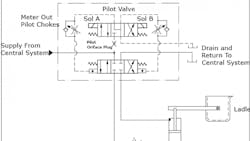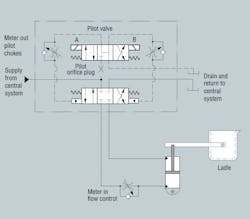Troubleshooting Challenge: Smelting plant’s hydraulic ladle can’t pour the liquid gold
A gold smelting plant couldn’t get the hydraulically operated ladle to tilt and pour molten gold into ingot molds. The hydraulic system for this part of the system had its pressure and return lines connected to a central supply. All the other functions supplied by this system worked well.
The tilt function was somewhat simple. A pilot-operated 3-position directional valve and a meter-in flow control were attached to the ladle to control the maximum tilt speed of a single cylinder. The pilot operated directional valve had meter-out pilot chokes to control the acceleration speed of the tilting ladle.
The cylinder piston seals had failed, and some of the seal material made its way back to the directional valve and locked up the main spool. Maintenance technicians removed the cylinder and directional valve for repair and sent them to a repair house for overhaul.
When they re-installed the valve and cylinder, they cleaned the tubing and made sure the line-mounted speed control was working and free of any contaminants.
When they commissioned the unit, they could not get the ladle to move in either direction. They adjusted the line-mounted flow control and pilot chokes fully counter-clockwise. They felt this would completely open these valves so they would not have any effect on the system.
The repair house had them remove the valve and confirm that the pilot pressure orifice was not plugged, that both spools moved freely, and that energizing the coil would shift the pilot spool. They confirmed the above and even removed the orifice plug but nothing would move.
Any idea what the problem might be?
Robert J. Sheaf Jr., is the founder and president of CFC Industrial Training, a Div. of CFC Solar, which provides technical training, consulting, and field services to any industry using fluid power technology. Visit www.cfc-solar.com for more information.
Find the solutionThink you know the answer? Submit solutions to [email protected]. The correct answer will be published in the next edition of “Troubleshooting Challenge.” All correct solutions will be entered for a chance at a $50 gift card — we will randomly select a winner from all correct answers. The winner’s name will be printed in the next edition of “Troubleshooting Challenge.” |
Solution to September’s rolling mill problem
The hydraulic circuit controlling the storage system relied on the relief valve to maintain a pressure 75 psi higher than the reducing valve. This worked fine when the remote proportional relief was isolated from the valves. However, when the two vent ports (remote control ports) were connected to the same pressure control, they would both be reducing and relieving at the same pressure, causing the system to overheat. What happened to the 75 psi differential they had when manually setting the maximum pressures?
The original Vickers CT-10 relief valve had a bias spring that was 75 psi stronger than the bias spring in the reducing valve, allowing the proportional relief to control both — maintaining the 75 psi differential no matter where the remote pressure was set below the maximum controls. Jon Rhodes, a CFC-Solar instructor, had the customer retrieve the old valve and reuse the stronger bias spring, which solved the overheating problem.
Rhodes also told them they could’ve installed a 75 psi check valve flowing from the vent port of the relief valve to the proportional control to accomplish the same 75 psi differential.
About the Author
Bob Sheaf
President
Robert J. Sheaf Jr., is the founder and president of CFC Insustrial Training, formerly Certified Fluid Consultants, part of CFC-Solar Inc. CFC-Solar provides technical training, consulting, and field services to any industry using fluid power technology.

Leaders relevant to this article:


